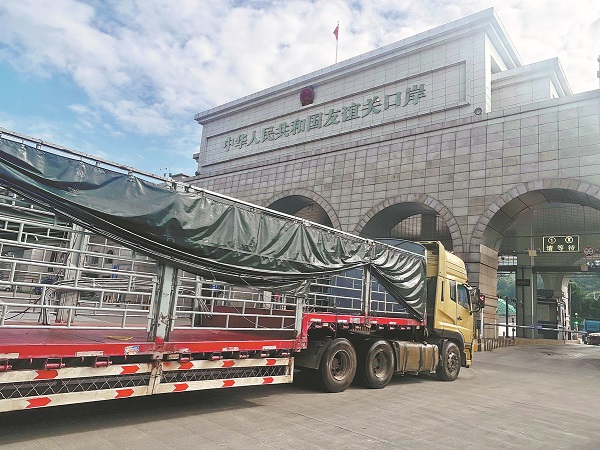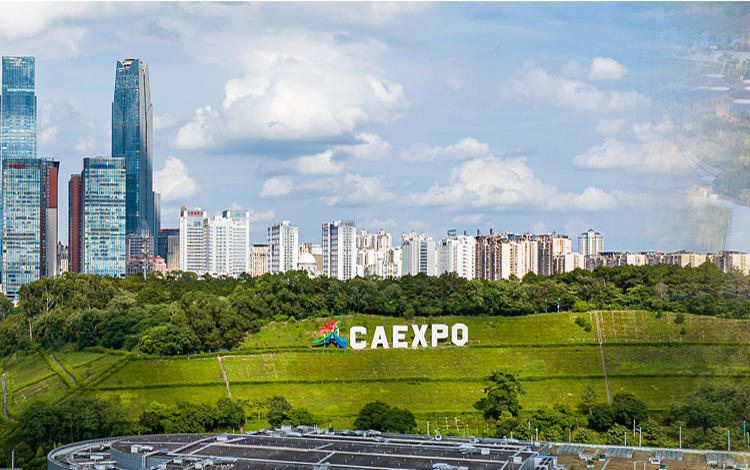Guangxi expedites border customs clearances

The Friendship Pass in Pingxiang, Guangxi. ZHAO JIA/CHINA DAILY
Open development
As an important land gateway of the New International Land-Sea Trade Corridor, a trade and logistics passage jointly built by provincial-level regions in western China and ASEAN members, the Friendship Pass is China's largest land fruit import and export port.
According to the regional government, the Friendship Pass has become the lowest-cost and fastest border road port connecting China and the Indo-China Peninsula. A total of 22 cross-border highway logistics lines have been opened, reaching more than 20 major cities in the Association of Southeast Asian Nations countries.
The enhanced efficiency in customs clearance and the development of cross-border cold chain logistics systems have facilitated safe and rapid inspection and release of imported fruits, enriching the table of Chinese consumers, bringing sweet opportunities to fruit farmers and traders in ASEAN, and boosting an already flourishing foreign trade economy.
Imported durian, lotus seeds, lychees and other Southeast Asian fruits are transferred to major logistics bases in Pingxiang before being distributed to major domestic markets.
"After the vehicle arrives at the port, it can complete the entire customs clearance process within 24 hours," said Yu Weipeng, a cargo agent for a logistics company in Guangxi.
Since the beginning of this year, the company's durian sales have increased by 20 percent compared with the same period last year, and the number of durian orders has increased to nearly 2,000 containers, Yu added.
According to an official from the customs office of the Friendship Pass, the port has implemented a "durian express lane" and a smart inspection system.
Figures from the customs of the Friendship Pass show that from January to June, agricultural products imported through the port reached 11.56 billion yuan ($1.63 billion), an increase of 513.2 percent from the same period last year. Among them, imported fruits totaled 11.39 billion yuan with a year-on-year increase of 520.6 percent.
Guangxi announced last year the establishment of special China-ASEAN fruit trading centers in Chongzuo, Nanning and Qinzhou, in a move to better facilitate fruit trade for China with ASEAN countries amid surging demand.
As the only province in China that is adjacent to ASEAN countries by land and sea, Guangxi serves as a frontier for China's open cooperation with its ASEAN neighbors, which has been the region's largest trading partner for 24 consecutive years.
In the first half of the year, imports from and exports to ASEAN countries through the Friendship Pass totaled 221.36 billion yuan, with an increase of 23.4 percent, with the main export commodities via the port mechanical and electrical products, accounting for over 70 percent of the total export value.
Common wealth
"Development is the foundation and the key to solving all problems in areas with large ethnic populations. While fully availing itself of its geographical advantages to grow its border trade economy, Guangxi has actively created conditions to advance rural vitalization across the board and continuously delivered tangible benefits to people," said Qin Juan, director of the Institute of Ethnology at the Guangxi Academy of Social Sciences.
Jingxi, a smaller city administered by Baise, a prefecture-level city with the largest border area between China and Vietnam, has prioritized border trade at its Longbang Port, located in the town of Longbang and one of the three key ports in Guangxi.
The Longbang (China)-Tra Linh (Vietnam) Port, including the Naxi (China)-Na Doong (Vietnam) Border Crossing, was upgraded and reopened as an international port in December, allowing the entry and exit of people, goods and cars.
Ma Zhenguo, an official of the Longbang (China)-Tra Linh (Vietnam) Cross-border Economic Cooperation Zone, said border trade has expanded to all 10 ASEAN countries, in an effort to revitalize border areas and enrich residents' lives.
Jingxi is striving to attract enterprises from inside and outside the region to settle in border areas, and is vigorously developing border trade processing industries, Ma added.
Nong Wenmeng, a general manager of an agricultural cooperative in Jingxi, said the cooperative takes advantage of the preferential policies for border residents, who enjoy a tariff-free policy of 8,000 yuan per person for imported and exported goods per day.
Goods including cashew nuts and frozen fish and shrimp are purchased from Vietnam and then resold to processing enterprises at the port, Nong said, adding that some products are reserved by merchants both within and outside the region and sold throughout the country.
Data from Guangxi shows that last year, the value of the processing volume of imported goods from the border trade at Longbang Port was 2.27 billion yuan, a year-on-year increase of 13.67 percent, creating 2,000 jobs for border residents and increasing their monthly income by more than 1,000 yuan on average.
The scale of Guangxi's border trade has ranked first among China's border provinces and regions for the past five years.
"Guangxi promotes development through opening-up, thus improving the livelihoods of residents and advancing high-quality development in border areas, which is conducive to uniting people's hearts and heightening a sense of identity of the Chinese nation," said Qin.
"As the largest developing country, China adheres to common prosperity and development of all ethnic groups, achieving social stability and economic growth. A stable China itself is a contribution to the world," she said.
China's experience in solving ethnic problems also contributes to managing ethnic affairs and handling ethnic relations for other countries, she added.
Contact the writers at zhaojia@chinadaily.com.cn














